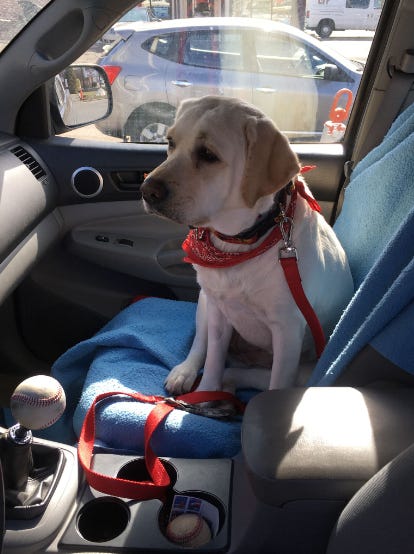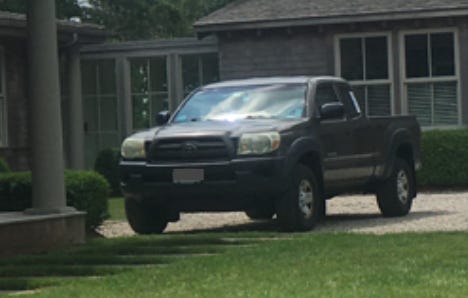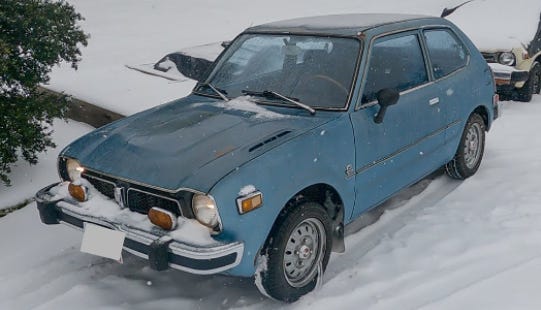It happened, of course, only four days before the world shut down for Christmas. I brought my extremely reliable Toyota Tacoma truck into my mechanic for some routine maintenance, an oil change and tire rotation. I had made the mistake of telling my colleague Kathy, who was looking into potential trucks for her son finishing college, that Toyota trucks are bulletproof and that I had hardly put a dime into mine. And when my sweetheart on the Cape shared what I considered to be unwarranted concerns about her much newer Jeep, I boasted that the 183,000 miles on my truck was only the beginning, that cars no longer die at 100,000 miles like in the old days, and that she was foolish to be thinking of her shiny red Wrangler as being old. If there is such a thing as jinxing yourself, I have only myself to blame. Speaking so confidently about my vehicle inevitably resulted in the auto repair debacle I have been faced with for the past week.
My 2009 Toyota Tacoma is now a bit of a classic, a 5-speed that I purchased during the residual portions of Hurricane Sandy hitting New England in 2012. I was driving a Subaru Outback at the time, the internal firewall of which was being devoured by chipmunks who, I was told, specifically like to get into the inner dashboard areas of Subarus where there is enough room for them to create nests to keep warm and dry. As a result, the front passenger side floor was routinely filled with water after any rainstorm. Superstorm Sandy inspired me to shop for a new vehicle. I picked out my current truck from the lot of a local dealer. There was a fancier Tacoma next to it, black with an automatic transmission and expensive side-rails but slightly more miles than the less attractive, sand colored one that I had my eyes on. For me, the more basic the better. The truck I preferred had a standard transmission and only 36,000 miles. It appeared to be a no frills mode of transportation, my preference after nursing the needs of what turned out to be a rather high-maintenance Subaru. I took the truck for a quick ride, then went back to the dealer and told them of my intentions to make a deal. Unaware that my car would resemble the English Channel within 48 hours, they said they couldn’t wait to put my Outback on the lot and that it would sell immediately. I made it clear that I wanted to quickly complete the sale on the spot, then come back the following night to make the switch. Trying to outrace the incoming storm, I drove back the next evening and drove away in my 2009 Toyota Tacoma. I have been driving this vehicle ever since, doing only minimal repairs along the way: replacing the bearings in one wheel, fixing a brake line, and reconnecting a detached muffler that I fixed myself with a gasket and clamp for 79 cents. But last week, my luck ran out after eleven virtually maintenance free years.
I arrived at B.J.’s Auto Repair in Norwell, Massachusetts for a scheduled oil change. In a somewhat favorable twist of fate, the truck decided to begin gushing some kind of fluid, maybe transmission and possibly power steering fluid, upon arrival at the garage. That the truck had decided to fall apart at the hands of a mechanic instead of in Boston or while crossing the Sagamore Bridge over to Cape Cod was a recognizable silver lining. This visit to B.J.’s was going to have to involve more than the typical oil change. B.J. Roussos, the long-time owner of B.J.'s, said the timing of the repair would depend on his ability to get parts, joking that my 1909 model might be hard to find pieces for. The next afternoon, he called me with bad news. The Tacoma was going to need an entirely new steering rack, a costly and time-consuming repair, and there was no way it could be done until after Christmas at the earliest. I was forced to contemplate the very future of my Toyota, a vehicle that has been incredibly dependable and valuable to me for more than a decade. Visions of all of my past vehicles began to flash before my eyes - the tiny 1975 Honda CVCC that I purchased for $350, my trusty 1972 Chevy Nova equipped with an infallible straight-six motor, and an entire series of Toyota Corollas that I bought during the 1980s from Bridgewater Auto Parts, a Toyota specific parts annex south of Boston. I thought back to the 1983 Toyota Tercel four-wheel drive station wagon that Jack Prihoda, my former boss at a Boston hotel, gave me when I was in need of a car after living in the city without a vehicle for years. It was a 5-speed manual, smelled like it was about to burst into flames when shifted into four-wheel drive, and required a wrench attached to the inner door to be able to roll down the driver’s side window. But in true Toyota form, the car ran like a charm despite the fact that the back end was rusty from Prihoda backing it into Boston’s Jamaica Pond occasionally doing some quick fishing along his daily commute. I thought about the 1989 Toyota Corolla that I spontaneously purchased to welcome in the new millennium from Nissenbaum’s, a Boston-Somerville junkyard. I chanced upon this car while on a trip to get a new tire for a neighbor who discovered her tire flattened after a Y2K celebration in Boston’s North End. I bought that Corolla from Nissenbaum’s with only 48,000 miles on it and drove it until it had 135,000 miles, the perfect city car where parking any vehicle requires front and back bumper contact in order to wrangle into a space. Running strong but rusting away, the hood of this Toyota had to be held down with duct tape by the summer of 2003, and I was once forced to assist a mechanic in trying to find a solid piece of the car’s underbody on which to reattach the Corolla’s dangling muffler on a return trip from Maine. I began to wonder if it was time to trade my truck in for something newer, but I was also beginning to sadly feel like giving up on the truck in its current state was like preparing to put down a family pet. If I were to trade in my truck, I would have little to no leverage in towing it onto a dealer’s lot and demanding value. I thought about the balance of potential new car payments that I would need to take on rather than spending the money up front on the cost of the repair. I put a call through to my mechanic, B.J., an honest broker and a first rate repairman, to get his opinion. When I was driving a less than dependable Mazda B-4000 truck two decades before, B.J. would always open up any conversation before doing a repair by asking, “How long are you planning on keeping this truck?” With the Toyota, this was not the case. B.J. offered sound advice mentioning that I already had a brand new replacement frame installed by Toyota free of charge due to a recall. “The truck has no rust,” he said. He agreed that the repair would be expensive but convincingly added, “The truck is not going to stop running.” He thought about it and said it would be difficult to go out and get another truck of equal value without spending a lot more money, pointing out that neither of us were driving cars in an effort to win a beauty contest. He said that we both drive cars that continue to run, and that my truck will continue to run for a long time. With that said along with the fact that my vehicle was currently immobilized in the hands of a skilled and trusted mechanic, I told him to move forward with the repair.
I used the days available before the truck was due to be fixed to reach out to a few dealers in order to exhaust my options and determine the value of my truck if I were to have it towed in for trade. I spoke with Kerry, a salesman at Copeland Toyota in Brockton, Massachusetts who said that the truck would probably warrant Kelly Blue Book value even in its current condition, who then put me on the phone with his manager. She was not quite as willing to commit to Kelly Blue Book figures without being able to inspect the vehicle. I told the sales manager that Kerry had suggested that I send a photo, which the sales manager finally allowed me to do. I prepared a nice little e-mail package proposal along with a photo of my freshly washed truck from a few years back. I never heard back from Copeland Toyota.
I then called McGee Toyota, a dealership that was a bit closer to me in the town of Hanover, Massachusetts. McGee said that they would gladly take the truck in trade but would not commit or even discuss trade value until it was on site and could be inspected. Because McGee is only a few miles from B.J.’s Auto Repair, I suggested they send out a representative to view my truck rather than have it towed to the lot. My idea was first met with laughter and then awkward silence. I then called Sullivan Toyota located halfway between the Cape and Boston and then a local Honda dealer, but found myself in a continuous circle of automated phone menu options. My choice was becoming clear. Because I was not in a strong position to negotiate and, as B.J. had explained, the only cost-effective lateral moves I could make would potentially lead to a much bigger investment for something of less utilitarian value, it looked like the best idea was to spend the money up front and fix the truck.
I have little interest in driving a fancy new car. The hutch that I need to eventually move from inside my garage would become a permanent part of my garage if I had a Honda Civic or a Corolla sitting in the driveway. All of the sticks and branches that I haul away every winter and spring would need to be cut into even smaller portions and shoved into the trunk or the backseat of a smaller vehicle. In essence, I would be stranded in a completely different way if I did not have my pick-up. I also like that I can put my old yellow lab comfortably into the truck and not worry about having to vacuum every time she gets out. And I especially enjoy not having to be worried about my vehicle’s exterior appearance. When bumped, scratched, or dinged in parking lots, I have casually responded to apologetic people who have lost control of runaway shopping carts or wind-blown doors by saying, “It’s ok. It’s only a truck.”
I called one of my wisest old friends down in Bristol, Rhode Island, who also happens to be the owner of a 2004 Toyota Tacoma that is closing in on 200,000 miles. He reminisced about a similar repair that he had done almost a decade ago, a repair that I remember him complaining about at the time that was far more costly than expected and caused him to raise questions about the future of his own truck. In looking back at that experience, he endorsed the idea of fixing the truck rather than trading it for something new. “It’s a Tacoma,” he said in a fraternal effort to reinstill my Toyota confidence that had apparently been shaken by the experience. “You take that thing to the end of the river.”
I have always flirted around with the idea of owning an old Jeep CJ-5, looking out for the perfect barn-find since roughly 1980. But authentic Jeeps keep getting older and more expensive and my sense of practicality always draws me back to my own automotive reality, that the best car is almost always a free car and the vehicle that I currently own serves my needs perfectly, a dependable vehicle that I can use to work around the house, putter around town, and make an occasional trip into Boston or down to Cape Cod.
The bottom line is, life sometimes gets more expensive than planned, and never at times when you necessarily expect it. An old buddy of mine offered wise perspective when sharing that he and his wife had just forked over $3,000 to get their new cat neutered (although he did not necessarily use that specific language). The truth is, my old Tacoma pick-up is exactly what I currently need, valuable to me in its own familiar way. And although I think there is still quite a bit of distance to go, by the time it does finally reach the end of the river I hope that my old Toyota will be as much of a classic as any old Jeep.










